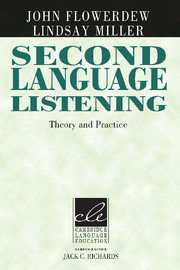Book contents
- Frontmatter
- Contents
- Series editor's preface
- Preface
- Acknowledgments
- Part I HISTORICAL BACKGROUND
- 1 Approaches to Language Teaching and the Role of Listening
- 2 Models of Listening
- 3 Types of Meaning for Listening
- 4 The Nature of Spoken Language
- 5 Learning Styles and Listening Strategies
- Part II A PEDAGOGICAL MODEL AND ITS APPLICATION
- Part III KEY ISSUES IN TEACHING AND TESTING
- Appendix: Concluding Questions for Reflection
- References
- Index
1 - Approaches to Language Teaching and the Role of Listening
Published online by Cambridge University Press: 04 February 2010
- Frontmatter
- Contents
- Series editor's preface
- Preface
- Acknowledgments
- Part I HISTORICAL BACKGROUND
- 1 Approaches to Language Teaching and the Role of Listening
- 2 Models of Listening
- 3 Types of Meaning for Listening
- 4 The Nature of Spoken Language
- 5 Learning Styles and Listening Strategies
- Part II A PEDAGOGICAL MODEL AND ITS APPLICATION
- Part III KEY ISSUES IN TEACHING AND TESTING
- Appendix: Concluding Questions for Reflection
- References
- Index
Summary
Introduction
In this first chapter, we look at the main approaches that have been used to teach listening. These approaches have, to a large extent, followed the approaches to general syllabus design and teaching methodology. As these general approaches have changed over the past 50 years, so new methods for teaching listening have been advocated. Different approaches to listening can be seen by examining exercises and tasks in published material. Richards (1993:3) states that one view of how to improve teaching is through the use of instructional materials, so that “quality of teaching will come about through the use of instructional materials that are based on findings of current theory and research.” Richards (ibid.) maintains that instructional materials can have a profound effect on teaching and that teachers rely on such materials to define the language courses they teach. He quotes one teacher who talked about some new materials she tried out: “This book has totally turned around the listening program in our school. We really didn't know what to do with listening before” (p. 6).
The approaches we discuss here are the grammar-translation approach, the direct-method approach, the grammar approach, the audio-lingual approach, the discrete-item approach, the communicative approach, the taskbased approach, the learner-strategy approach, and the integrated approach. After introducing each approach, we identify the main learning goal with respect to listening. These learning goals are based on Morley (1995). Although some of these may not be considered bona fide approaches themselves, we consider them all to be “approaches” because they have influenced the ways in which language has been taught.
- Type
- Chapter
- Information
- Second Language ListeningTheory and Practice, pp. 3 - 20Publisher: Cambridge University PressPrint publication year: 2005



